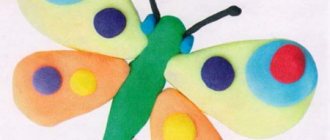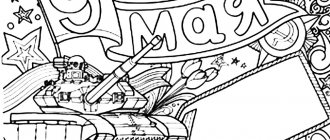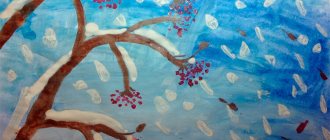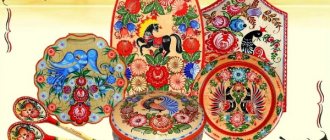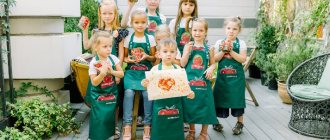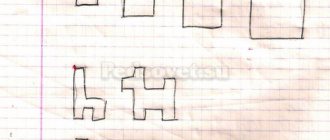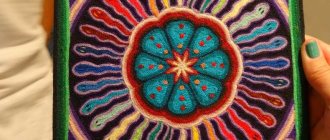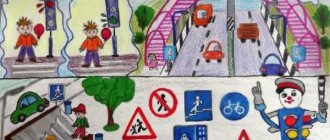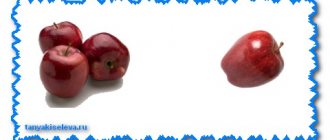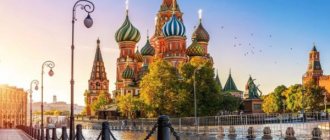Drawing lesson in the preparatory group "Spasskaya Tower of the Kremlin"
GCD for drawing and speech development according to the Federal State Educational Standard of Education
on the topic “Spasskaya Tower of the Kremlin” in the preparatory group.
Teacher 1st category Mytishchi
Preschool educational institution No. 76 “Scarlet Sails”
Nikiforova Nina Valerievna
Tasks:
Cognitive development:
Expand children's knowledge about Moscow - the capital of our Russia.
Introduce the historical past of Moscow. Expand children's knowledge about the Kremlin and its attractions.
Social and communicative development:
To form patriotic feelings in children: love for their hometown, pride in the people living in it - Muscovites.
Speech development:
Enrich the vocabulary with the concepts: “Kremlin”, “fortress”, “chimes”, “Spasskaya Tower”, “white stone”, “landmark”, “wooden”, “brick”.
Artistic and aesthetic development:
To develop the ability to convey in a drawing the architecture of the main Kremlin tower - Spasskaya, conveying its shape. To promote mastery of compositional skills: arrange an object on a sheet, taking into account its proportions. Strengthen children's ability to draw with a brush in different ways: wide lines - with the whole brush, thin lines - with the tip of the brush; apply strokes - when drawing individual details.
Teach children to analyze their work by comparing it with a model.
Preliminary work:
A conversation about the capital of our Motherland, Moscow. Reading poems about Moscow and the Spasskaya Tower to children.
Material used:
Magnetic board with photographs and illustrations of the Kremlin's Spasskaya Tower, gouache, a sheet of A4 paper, a small model of the Kremlin, palette, napkins, jars of water, plastic trays for gouache.
Progress of the lesson:
1 part
Educator: Guys, we live in a big country! What is it called? (Russia)
Educator: - Name the capital of Russia? (Moscow)
Poem reading:
Such a big old city,
My country is proud of him!
He is the head of all cities,
The capital of the Motherland is Moscow!
-Moscow is a big and beautiful city. There are many museums, theaters, stadiums, parks, squares. Beautiful, tall buildings.
Educator: Children, why is it located in the center of Moscow? (Kremlin)
Educator: Children, look at the picture of the Kremlin!!! Who can tell me where the Kremlin is in Moscow?
Children: On Red Square.
Educator: Why is the square called red?
Children: Because the Kremlin is red and the buildings are made of red bricks,
Educator: What did the word red mean in the old days?
Children: Previously in Rus' the word red meant “beautiful”, “chief”
Educator: That's right, guys.
Educator: The Kremlin was made of wood and the walls around it were also made of wood. Wooden high fence, wooden towers, bell towers, houses inside
The Kremlin - everything was made of wood. Tell me what kind of wood was used to build the fortress wall and most of the internal buildings.
Educator: Yes, that's true. Guys, the word Kremlin means fortress. Previously, in Rus', people built a fortress in order to fence their home, and
also to protect yourself. Who do you think the Kremlin residents were protecting themselves from?
Children: from enemies, from wild animals.
Educator: Well done! Since the Kremlin is based on a high hill, enemies could be seen from a greater distance, and the rivers served
a natural obstacle in their path.
Educator: The walls of the Kremlin are jagged, powerful, which end with brick battlements, also called “swallow tails”. Who should I
will he say why they built battlements on the wall, why didn’t they make it level?
Children: The battlements helped warriors defend themselves from the enemy. Narrow slits helped to aim at enemies.
Educator: There are many towers outside the walls of the Kremlin, we looked at them and said that each tower has its own history. Who can tell me which one?
the most important tower of the Kremlin?
Guys, guess the riddle and you will find out what is installed on this tower.
Two hundred years pass, and everything is in place. They walk like that! Teak! - So! Teak! - So! /Watch/
- Well done. The main clock of our country, the chimes, is installed on this tower. They strike every fifteen minutes. And the new year begins as soon as the chimes strike twelve times on the night of December 31 to January 1.
And the top of the Spasskaya Tower is decorated with a five-pointed ruby star.
The clock of the Kremlin tower is striking,
The stars are fading, the day is melting...
Goodbye, yesterday,
Hello, new bright day! (Yu. Entin, excerpt from the song “Song of the Bells”)
Educator: Children, would you like to draw this most beautiful tower of our Moscow?
Children: Yes!!!
Educator: Now let’s rest a little:
Tick-tock, tick-tock, who in the house can do that? This is a pendulum in a clock, Beats every beat (Tilts left and right.) And in the clock sits a cuckoo, She has her own hut. (Children sit down in a deep squat.) The bird will spend time, hide behind the door again, (Squats.) The arrows move in a circle. They don't touch each other. (Rotate your body to the right.) You and I will turn counterclockwise. (Rotate your body to the left.) And the clock goes and goes, (Walks in place.) Sometimes it suddenly lags behind. (Slow down the pace of walking.) And sometimes they are in a hurry, As if they want to run away! (Running in place.) If they are not turned on, then they completely stand up. (Children stop.)
Educator: I invite you to draw the Spasskaya Tower.
part 2
In the group, everything is laid out on the tables for drawing, and on easels there are drawings, a photo of the Spasskaya Tower, and a model
Spasskaya Tower.
Educator: Before we start drawing, answer the question, what will we use for the children to draw?
Children: Gouache.
Educator: Please note that the tower and the Kremlin wall are red. And who can say why you have two brushes on your table, one thin and the other thick?
Children: We paint everything with a thick brush, and with a thin brush, whoever has time to draw before others, we draw small details.
Educator. And now we will proceed to the image of the Spasskaya Tower. Place the sheet horizontally. Find the middle of the sheet, draw a rectangle there. On it, exactly in the middle, we will draw a square in which there will be a clock - chimes. Now we draw a triangle with a star on it. All that remains is to finish drawing the walls and decorate them, draw the Spassky Gate in the middle. Let's get to work.
Children sit down and draw.
Educator: Do not allow excess water to get into the gouache, and also do not allow painting with a dry brush. Rinse the brush well to prevent mixing of several colors. We do not leave the brush in a jar of water even for a short time, but place it on the palette to avoid bending the brush.
Part 3
RESULT OF THE LESSON
At the end of the lesson, the teacher analyzes the finished children's work.
infourok.ru
Abstract of educational activities for cognitive development in the senior group on the topic “Moscow Kremlin”
Goal: to give children knowledge about the history of the Moscow Kremlin.
Tasks.
- Continue to introduce children to the sights of Moscow (Moscow Kremlin).
- To form in children a cognitive interest in the sights of the Kremlin.
- Continue to introduce children to the symbols of Russia (coat of arms).
- To develop children’s coherent speech and the ability to answer questions in complete sentences.
- To instill in children a sense of patriotism and love for their Motherland.
- Foster a sense of mutual assistance through cooperation during direct educational activities.
Preliminary work: examination and discussion of illustrations depicting the Moscow Kremlin and Red Square.
Vocabulary work: guide, excursion, Capital, Motherland, seats, ticket office, fenced place, diagram, fortress, antiquity, enemies, Prince Dmitry Donskoy, collapsed, “our” days, Kremlin wall, tower, forest, low, mysterious, secret, hiding place, well, secret exit, a long time ago, Tsar Ivan the Terrible, built-in, shelter, Moscow River, passage, mechanism, erect, Chimes, country, Grand entrance, coat of arms, state, president, central, Red Square, described , ruby, arch, lace.
Materials for GCD: projector; audio recording of the chimes; pictures and slides with Kremlin sights; diagrams for fixing the composition of the number; cards with numbers from “1” to “9”; simple pencils; colour pencils; counting sticks; anagrams with encrypted words: “Kremlin”, “Tower”, “Wall”, “Star”; coloring sheets with images of the Kremlin's Spasskaya Tower, on which the Chimes are encrypted; slides with images of Dmitry Donskoy and Ivan the Terrible.
Organizing time.
Educator: Guys, today we have an unusual lesson, now we will go on an excursion to the capital of our Motherland. What is the name of our capital? (Children's answers) Moscow. Guys, what do you think a tour is? (Children's answers) Correct! An excursion is a collective journey to beautiful, important places.
Usually people go on an excursion on a special excursion bus, which has seats with numbers and a tour guide. Today I will be your guide! And you will be my assistants! Agreed? But, before we go on a trip, let’s find out what seats each of us will sit on the bus. To do this, you need to obtain seat tickets. Now we will receive them at the Ticket Office.
(Children go to the cash register, and the teacher gives them “tickets”, cards with a number series.)
Educator: Look, guys, our tickets are not simple, they have a number series, it contains numbers from 1 to 10, look at it carefully, did you notice anything? That's right, it's missing one number. You need to find it among the cards (everyone has them) and put it in the empty window. You also have pencils; anyone who wants can write the missing number themselves in the empty window. This number will be your number on the tour bus.
(Children who find it difficult to complete a task are helped by other children and the teacher.)
GCD move.
Educator: Well done, now we can take our seats and go on an excursion.
(Children take their places according to the number that is missing in the number line.)
Educator: So, I want to show you one of the most beautiful places in Moscow - the Moscow Kremlin, from which the construction of our beautiful capital began.
(Show a slide with a panoramic image of the Kremlin.)
What is the Kremlin? (Children's answers)
I'll remind you. This is a fenced place, a fortress that people built in the old days to protect themselves from enemies and wild animals. At first the Kremlin was built of wood, but the wooden walls were burned by enemies.
(Show a slide showing a wooden Kremlin.)
Then the Russian prince Dmitry Donskoy (Show a slide with an image of Dmitry Donskoy), on the site of the burnt Kremlin, built a new one, made of white stone.
(Show a slide with a picture of the white stone Kremlin.)
Over time, its walls collapsed and then a new Kremlin was built - from red brick. This is how it has remained to this day.
(Show a slide showing the modern Kremlin.)
Let's take a look at the Kremlin now. It has 20 towers connected to each other by a wall (built into the wall). I will show you the most interesting towers of the Moscow Kremlin.
- Borovitskaya Tower - the name of this tower reminds us that once upon a time there was a thick forest rustling here on the hill. What is boron? (Children's answers.) That's right, this is a pine forest. (Show a slide showing the Borovitskaya Tower.)
- The next tower is Tainitskaya. She is not tall. What does its name tell us? (Children's answers) Correct. This means that she is mysterious, keeping some kind of secret. Indeed, there was once a hiding place inside it. Not just one, but two! Well and secret exit. Only that was a long time ago. (Show a slide showing the Taynitskaya Tower.)
- Look at the next tower. It's called Tsarskaya. Why do you think? (Children's answers) It is called that because there was a tower on it, from which the first Russian Tsar Ivan the Terrible watched everyone. (Show slides with images of the Tsar’s Tower and Ivan the Terrible.)
- And this is the Vodovzvodnaya Tower. It had a well and a secret passage to the Moscow River, as well as a mechanism through which water flowed for watering the Kremlin gardens. Vodovzvodnaya, i.e. erected, raised the water. (Show a slide showing the Vodovzvodnaya Tower.)
- Look, this is a tower with a funny name - Kutafya. (Show a slide showing the Kutafya Tower.) It is not built into the Kremlin wall and is not at all like other towers. Why? (Children's answers.) It served to guard the bridges leading to the Kremlin. Its name comes from the word “kut”, which means shelter.
Interesting? We have already learned a lot of new things about the Moscow Kremlin, I suggest you relax a little and continue our journey. Do you agree?
Get up and repeat after me! (A dynamic pause “Moscow Kremlin” is held.)
I love my Capital - (children show a heart with their hands.)
There are many beautiful places in it! (put their hand to their head and look in different directions.)
Mom and I sit in the car (squat down)
And let's go see everything! (stand up and move their hands)
Here is a big palace, huge, (put both hands forward and show)
It's called the Kremlin!
Let's go for a walk here (they walk in place)
We'll look at everything with mom in it! (put hand to head and look in different directions)
Educator: We continue our acquaintance with the Kremlin! Look - this is the most important and beautiful tower of the Kremlin - Spasskaya. (Show a slide with an image of the Spasskaya Tower.) What do we see on it? (Big clock.) What are they called? (Chimes.) That's right! The chimes are a huge clock with golden numbers. Let's hear how they sound.
(Audio recording of the “Chime” sounds.)
Sound familiar? Where could we hear him? (After the New Year's greeting from Russian President V.V. Putin) This clock shows the time by which all people in our country live.
Remember when I said that the Spasskaya Tower is considered the main tower of the Kremlin? Want to know why?
- It houses the main entrance to the Kremlin.
- All kings and important people passed through it, taking off their hats. They were just passing through, not passing through. What did people drive before? (Horses)
- The first coat of arms of Russia appeared on it - the Double-Headed Eagle.
- The Spasskaya Tower is the central one and can be seen first from Red Square.
And did I also tell you that she is not only the most important, but also the most important? Right! Beautiful! But why is she so good? I want you to look at her and describe her beauty! (Children's expected answers.)
The teacher’s additions to the children’s answers:
- There is a huge gold watch on it.
- It is built as if from three parts: At the bottom it is rectangular, its middle, when viewed from the side, is oval, and the very top is triangular, pointed, with a beautiful ruby star.
- The Spasskaya Tower is built of bricks of different colors (white, green, red)
- In the middle of the tower we can see small arches in the shape of inverted hearts, decorated on top with a beautiful white pattern reminiscent of lace.
Final part.
Educator: Our excursion has come to an end. I want to thank you, it was a pleasure to travel with you. Were you interested? What did you like most? (Children's answers)
But today we were not able to see everything that is interesting in the Kremlin. How many of you would like to go and see the real Kremlin? (Children's answers.)
I am sure that if you tell your parents about our trip, they will definitely take you to the Kremlin. And then you will tell me about it!
While you haven’t gone there yet, in our group there will be an album with the sights of the Kremlin, which you can look at, and if you are interested in something, ask me. Agreed?
Spasskaya Tower - the main gate of the Kremlin
The Spasskaya Tower is an integral part of Red Square and the Moscow Kremlin. The tower is the main entrance to the Kremlin, due to which it has gained great popularity among Russians and tourists from different countries. Almost everyone who has visited Red Square has a photo in their archive with the tower in the background. This majestic structure attracts the attention of everyone passing by. And it makes you raise your head and admire the majestic building.
photo of the Kremlin tower
Story
The Spasskaya Tower was founded and subsequently built in 1491 according to a design commissioned from the Italian architect Pietro Antonio Solari. The tower became the first and main defensive structure of the eastern wall. Initially, the tower was called Frolovska because of its proximity to the Church of St. Frol. Subsequently, in 1658, it was renamed Spasskaya by order of the sovereign. The reason for the renaming was the icon of the Savior Not Made by Hands. Which was installed on the towers. Unfortunately, the icon has not survived to this day, but the place where it stood remains visible to this day.
photo of a tower with an eagle
Kremlin tower
history of the tower
photo view of the facade
Description of the structure
These days, the Spasskaya Tower is a highlight of excursions around Moscow. At the base of the tower there are the front gates leading to the Moscow Kremlin. The gate is closed by a massive grille, which is raised using a huge mechanism. The tower itself is 71 meters high, with ten floors. On three of the ten floors there is a mechanism of the well-known Kremlin chimes, against the background of which, on New Year's Eve, the President of Russia speaks his message to the citizens of Russia. These watches have become one of the most famous symbols of Russia. Don’t forget to look at the fascinating article photo of Pavlovsky Posad.
appearance
Spassky chimes
Spassky chimes at night
reconstruction of the tower
Reconstruction of the tower
Throughout its history, the Spasskaya Tower has been rebuilt and completed (reconstructed) more than once. In the seventeenth century, the tower received a new look. Due to the built-on stone tent. The superstructure was designed and built under the supervision of architects Galoev and Ogurtsov. At the top of the tower there was a high spire with two main eagle. Symbol of the Russian Empire. In 1935, the eagle was removed from the spire and replaced with a red five-pointed star. In 1937, the star was replaced again by another larger star. The star also gained the ability to rotate from wind currents.
concert on red square
main gate of Russia
An interesting incident from the history of “Napoleon and the Tower”
When Napoleon ruled Moscow. It destroyed many historical and significant buildings. And when he began to destroy the Kremlin, the defenders managed to recapture the Spasskaya Tower and preserve it in its original form.
two towers at night photo
five pointed star
two towers at night
The Spasskaya Tower is the Kremlin Tower and is located between the Senate and Tsarskaya towers. If you are in Moscow, be sure to visit the famous tower. Also, if you liked the article, be sure to leave your review in the comments or subscribe to one of our channels. And receive the latest articles and photos for them.
russiakrasava.ru
